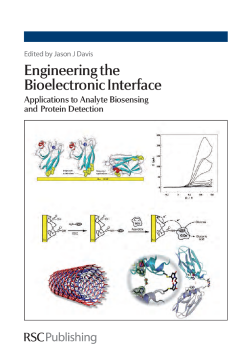
BOOK
Engineering the Bioelectronic Interface
Paul Bernhardt | S J Perkins | Yuki Hanyu | Wang Xi | Itamar Willner | Ran Tel-Vered | James F Rusling | Xin Yu | Bernard Munge | Song-Nyon Kim | Fotios Papadimitrakopoulos | Dirk A Heering | Gerard Canters | Vikash Dodhia | Gianfranco Gilardi | Jan Tkac | Paul Ko-Ferrigno | Jason Davis
(2009)
Additional Information
Book Details
Abstract
The interfacing of man-made electronics with redox proteins and enzymes not only tells us a great deal about the levels of sophistication active in biology, but also paves the way to using it in derived sensory devices. Some of these have already had a profound impact on both clinical diagnostics and the quality of life enjoyed by those unfortunate enough to live with disease. Though much remains to be learnt about controlling and optimising these interfacial interactions, their potential uses are, if anything, growing. Written by leaders in the field, this is the only book to focus on the generation of biosensing interfaces with analyses and control at the molecular level. Some of these are enzyme based, others associated with the generation of surfaces for protein-protein recognition. Summaries of state-of-the-art investigations into the interfacing of structurally complex molecular species with electrode surfaces are included along with their design, analysis and potential application. Studies into the "wiring" of biomolecules to man-made surfaces through the use of delocalised "molecular wires" or carbon nanotubes are detailed as are the application of surface chemical and genetic engineering methods to the construction of robust, orientated biomolecular monolayers.
Paul V. Bernhardt received his BSc Hons and PhD from the University of Newcastle (Australia) in the area of macrocyclic chemistry. Following postdoctoral positions at the University of Basel, Switzerland and the Australian National University (Canberra), he joined the University of Queensland in 1995 where he is currently Professor of Chemistry. He was awarded the degree of DSc from the University of Newcastle in 2008. His current area of research is biological inorganic chemistry including medicinally useful iron chelators and also enzyme electrochemistry. Gerard W. Canters received his degree in Chemistry/Chemical Physics from the University of Amsterdam and his PhD from the University of Nijmegen. In 1969 he received the Royal Dutch Shell award for young chemists. After a post-doctoral fellowship at the University of North Carolina, he joined the staff at Leiden University. In 1982 he established the Metallo-protein Group and in 1992 he was appointed Professor of Biophysical Chemistry at Leiden University. Gerard's research interests involve the molecular characterization of proteins involved in biological electron transfer. His current research is concerned with Forster-resonance-energy transfer (FRET). He has fulfilled various guest professorships, among them a visiting professorship at the Royal Danish Veterinary University, and a 'Kugie and Bert Vallee' professorship at Oxford University. Itamar Willner is a professor in the Institute of Chemistry at the Hebrew University of Jerusalem. He is an expert in bioelectrochemistry, bioelectronics and nanobiotechnology. His research activities include the development of electrochemical and optical biosensors, modification of electrodes with biomolecules, assembly of biomolecule-nanoparticle hybrid systems for electronic and optoelectronic applications, the use of biomolecular scaffolds for the synthesis of functional electronic and optoelectronic devices, and biocomputing. James F. Rusling was awarded a B.Sc. in Chemistry from Drexel University in 1969 and a PhD in Chemistry from Clarkson University in 1979. In the same year, he joined the faculty of the University of Connecticut, where he currently is Professor of Chemistry and Professor of Cell Biology (Health Center). His research interests include nanoscience-based sensor arrays for toxicity prediction and early cancer detection, biocatalysis, and nanoparticle-based drug delivery. He has authored over 275 refereed research papers, and several books and monographs.
